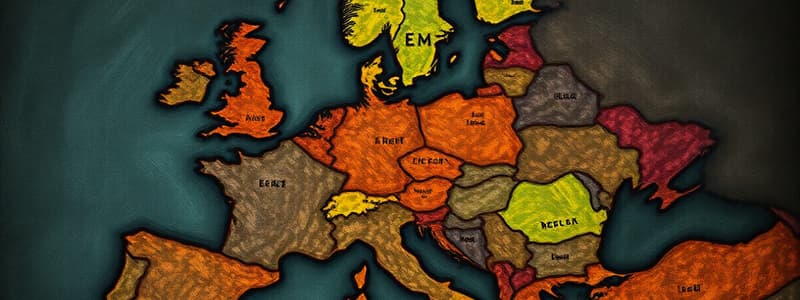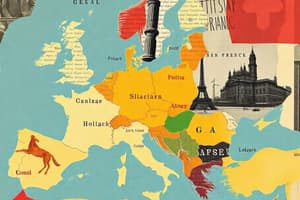Podcast
Questions and Answers
Social safety nets in Europe are considered weak, contributing to higher stress levels among the population.
Social safety nets in Europe are considered weak, contributing to higher stress levels among the population.
False (B)
Religious participation in Western Europe is notably robust.
Religious participation in Western Europe is notably robust.
False (B)
Mediterranean Europe, including regions like Italy, is characterized by a more relaxed pace of life compared to Western Europe.
Mediterranean Europe, including regions like Italy, is characterized by a more relaxed pace of life compared to Western Europe.
True (A)
Siestas, which are brief afternoon naps, are becoming less common in Mediterranean Europe, especially in the southern regions.
Siestas, which are brief afternoon naps, are becoming less common in Mediterranean Europe, especially in the southern regions.
Language trees illustrate the geographical distribution of languages across different continents.
Language trees illustrate the geographical distribution of languages across different continents.
Ancient Rome's influence on Europe included ideas about law, government, and military force.
Ancient Rome's influence on Europe included ideas about law, government, and military force.
The European Union was officially established before the European Economic Community.
The European Union was officially established before the European Economic Community.
World War I significantly altered European borders, leading to the dissolution of empires like the Ottoman and Austro-Hungarian empires.
World War I significantly altered European borders, leading to the dissolution of empires like the Ottoman and Austro-Hungarian empires.
Greece is frequently cited as the origin of democracy and the idea of citizenship.
Greece is frequently cited as the origin of democracy and the idea of citizenship.
The fall of the Soviet Union ended Russia's influence in Eastern Europe.
The fall of the Soviet Union ended Russia's influence in Eastern Europe.
The European Union consists of 28 member states that promote free trade and cooperation among themselves.
The European Union consists of 28 member states that promote free trade and cooperation among themselves.
Political geography studies the interaction between government, citizens, and countries, along with their internal and external impacts.
Political geography studies the interaction between government, citizens, and countries, along with their internal and external impacts.
The European Union was formed primarily to address economic needs in Western Europe after World War II.
The European Union was formed primarily to address economic needs in Western Europe after World War II.
The Maastricht Treaty and the Treaty of Amsterdam are foundational agreements for the European Union.
The Maastricht Treaty and the Treaty of Amsterdam are foundational agreements for the European Union.
The EU's Common Foreign and Security Policy (CFSP) aims to destabilize international relations.
The EU's Common Foreign and Security Policy (CFSP) aims to destabilize international relations.
The Common Security and Defense Policy (CSDP) is the EU's primary tool for crisis management, utilizing a combination of civilian and military resources.
The Common Security and Defense Policy (CSDP) is the EU's primary tool for crisis management, utilizing a combination of civilian and military resources.
The European Neighbourhood Policy encourages collaboration with nearby nations but discourages political and economic partnerships.
The European Neighbourhood Policy encourages collaboration with nearby nations but discourages political and economic partnerships.
The High Representative for Foreign Affairs & Security Policy leads EU diplomatic efforts.
The High Representative for Foreign Affairs & Security Policy leads EU diplomatic efforts.
European culture is characterized by a strong emphasis on individualism and materialism.
European culture is characterized by a strong emphasis on individualism and materialism.
Europe has a higher population density compared to the United States.
Europe has a higher population density compared to the United States.
English is the most commonly spoken first language in Europe.
English is the most commonly spoken first language in Europe.
Western Europe, home to major financial centers like Paris and London, is considered the wealthiest part of Europe.
Western Europe, home to major financial centers like Paris and London, is considered the wealthiest part of Europe.
Flashcards
Political Geography
Political Geography
The study of the relationships between governments, citizens, and countries.
Birthplace of Democracy
Birthplace of Democracy
Ancient Greece is known as the origin of democracy and citizenship.
Influence of Ancient Rome
Influence of Ancient Rome
Rome shaped European ideas about law, government, and military.
World War I Impact
World War I Impact
Signup and view all the flashcards
European Union (EU)
European Union (EU)
Signup and view all the flashcards
European Parliament
European Parliament
Signup and view all the flashcards
Iron Curtain
Iron Curtain
Signup and view all the flashcards
Siestas
Siestas
Signup and view all the flashcards
Mediterranean Europe
Mediterranean Europe
Signup and view all the flashcards
Eastern European culture
Eastern European culture
Signup and view all the flashcards
Language Tree
Language Tree
Signup and view all the flashcards
Water and settlements
Water and settlements
Signup and view all the flashcards
Marshall Plan
Marshall Plan
Signup and view all the flashcards
Maastricht Treaty
Maastricht Treaty
Signup and view all the flashcards
Common Foreign and Security Policy (CFSP)
Common Foreign and Security Policy (CFSP)
Signup and view all the flashcards
Crisis Management
Crisis Management
Signup and view all the flashcards
European Neighbourhood Policy
European Neighbourhood Policy
Signup and view all the flashcards
High Representative for Foreign Affairs
High Representative for Foreign Affairs
Signup and view all the flashcards
Cultural Attitudes in Europe
Cultural Attitudes in Europe
Signup and view all the flashcards
Secularism in Europe
Secularism in Europe
Signup and view all the flashcards
Study Notes
Political Geography of Europe
- Political geography studies the relationships between governments, citizens, and countries, both internal and external, and their impact.
- Ancient Greek and Roman ideas about government and law significantly impact Europe today. Greece is the birthplace of democracy, while Rome influenced law and military systems.
- World War I redrew European borders, leading to the creation of many new countries.
- World War II ended European empires and established the Iron Curtain, separating Western (US-aligned) and Eastern (USSR-aligned) Europe.
- The Soviet Union's collapse in the 1980s had lasting effects on the political geography of Europe.
- The European Economic Community (EEC) later evolved into the European Union (EU), a political and economic union of 28 member states.
- The EU is an influential institution with numerous bodies, including the European Central Bank, Court of Justice, and European Parliament, elected by EU citizens.
- The EU faces continuing political controversies, such as bailouts for struggling countries, loss of sovereignty, and immigration.
- Despite challenges, the EU has stabilized Europe economically and politically.
Influence of Geographic Factors on Politics in Europe
- European history involves numerous empires, religions, and cultures.
- The Iron Curtain separated Western and Eastern Europe.
- The European Union fosters free trade and cooperation among member states.
EU Foreign Policy
- The Common Foreign and Security Policy (CFSP) aims to improve international stability, encourage democracy, boost prosperity, and uphold the rule of law, utilizing sanctions, conflict prevention, weapons controls, and crisis management.
- The Common Security and Defense Policy (CSDP) is the EU's crisis management tool.
- The European Neighbourhood Policy fosters partnerships with neighboring nations, promoting democracy and economic cooperation.
- The EU employs trained staff to coordinate foreign policy, including the High Representative for Foreign Affairs & Security Policy, the Foreign Affairs Council, the EEAS, and Special Representatives.
European Customs and Culture
- Europe is a large area with diverse customs and cultures.
- European culture is generally laid-back, emphasizing family time and historical perspective.
- Higher population density in Europe affects daily life.
- European culture is less individualistic and materialistic compared to American culture.
- Politics are generally more liberal.
- Europe has a strong focus on human rights and stricter laws.
- Europeans have a more relaxed attitude towards alcohol and underage drinking.
- Patriotism is less prominent.
- Police are generally less aggressive.
- Europe is becoming increasingly secular, with Christianity prevalent albeit with diverse denominations.
- Education tends to follow a common core curriculum.
- Europe contains at least 87 ethnic groups and numerous languages.
- English is the most commonly spoken second language.
Western and Mediterranean Europe
- Western Europe (UK, France, Spain, Germany, etc.) is the wealthiest part, with fast-paced city life and strong social safety nets.
- Life in western Europe is generally laid-back.
- Mediterranean Europe (Spain, France, Italy, Greece, etc.) is even more relaxed, with emphasis on family time and religious traditions.
- Siestas are common in the Mediterranean.
- Eastern Europe shares characteristics with Western Europe, particularly in cities, but retains traditional culture in rural areas.
Language and Settlement Patterns
- Language trees demonstrate the relationships between languages and settlement patterns.
- Comparisons between language trees and maps reveal migration patterns.
Middle East and Africa Settlements
- Water is a crucial factor in settlement location in the Middle East and Africa.
- Harbors and plateaus influenced settlement for defense and trade.
- Modern settlements are influenced by natural resources like oil and diamonds.
- Natural resources create contention between nations.
Studying That Suits You
Use AI to generate personalized quizzes and flashcards to suit your learning preferences.



